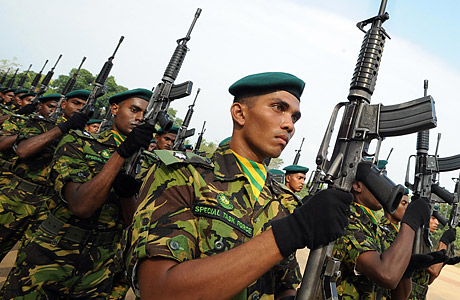Up to a quarter of a million people were crammed into an area the size of New York’s central park, which has been regularly bombarded for four months. The UN estimated that between 7,000 and 8,000 civilians were killed during the attacks. A report by the Times, a British daily, claimed that the death toll – from artillery fire, summary executions, disease and starvation – could have been as high as 20,000.
Last week the doctors, who have been held in incommunicado detention since their arrest, claimed that only 750 civilians died and that they had made up their earlier accounts for propaganda on behalf of the Tamil Tigers (LTTE). Looking nervous and flanked by government officials, they said that the only shortages of food and medicine in the blockaded area were due to LTTE appropriations and that there had been little damage to medical facilities. They said that they regretted their previous “lies” and that no pressure had been exerted on them to change their statements. Sri Lanka was a democratic country, one said, and so they were no longer lying. As the Times has noted, the main impact of the press conference was to raise “fresh fears that Sri Lanka, known as a holiday paradise to millions of western tourists, has quietly become a quasi-Stalinist state”.

The tragedy is that Sri Lanka is indeed a democracy, with an independent judiciary and, until recently, a free press. It has suffered a brutal civil war in which the LTTE has committed countless atrocities from suicide bombings, to ethnic cleansing, deliberate attacks on civilians and the forced recruitment of child soldiers. The LTTE compelled hundreds of thousands of people to remain in its last stronghold as human shields and the protests of its diaspora sympathisers about the resulting carnage deserve to be treated as hypocritical cant.
One estimate said that 1,400 are dying in the camps every week.
The Sri Lankan government could have made a reasonable case that some security restrictions are necessary in the conflict’s aftermath, but it has instead treated all those who question their proportionality as “fifth columnists”. Earlier this week, the International Bar Association (IBA) expressed its alarm at the publication of an article on the ministry for defence’s website entitled “Traitors in black coats flocked together?” which contained the names and photographs of lawyers defending a Sri Lankan newspaper in a court case. The IBA had earlier criticised the government for a similar article which implied that defence lawyers were terrorist suspects.
Foreign aid workers are now regularly having their visa requests denied, forcing them out of the country, while local staff are being arrested on trumped up charges. Journalists, lawyers and human rights activists are being abducted, beaten up, tortured and killed. Sri Lanka’s president, Mahinda Rajapaksa, is basking in popularity amongst the country’s Sinhalese majority and the Economist recently described him as “cultivating the image of an elected monarch” and deliberately whipping up Sinhalese chauvinism. Meanwhile the UN human rights council has yet again disgraced itself with a resolution praising Sri Lanka’s human rights record.
But last week’s press conference may come to be seen as overkill. The conflict almost bankrupted Sri Lanka, which is currently seeking a $1.9bn loan from the International Monetary Fund, and its government cannot defy international opinion indefinitely. The pressure for an independent investigation into alleged war crimes at the end of the conflict is not going to go away and the more news that emerges the less credible the government’s position becomes. Although aid organisations have deliberately refrained from commenting on the political situation, simple accounts of their work contradict the official line. Medecins sans Frontieres, for example, has just reported that its staff performed 4,000 surgical operations on conflict-related injuries and dressed 3,000 wounds in the last few months, which is hardly compatible with the doctors’ new claims.
The irony is that the doctors almost certainly were pressurised to lie about the situation by the LTTE but are now clearly under pressure to support the government’s narrative. Only an independent inquiry can establish the truth, and the government’s latest stunt should strengthen the calls for one.
Source : The Guardian




